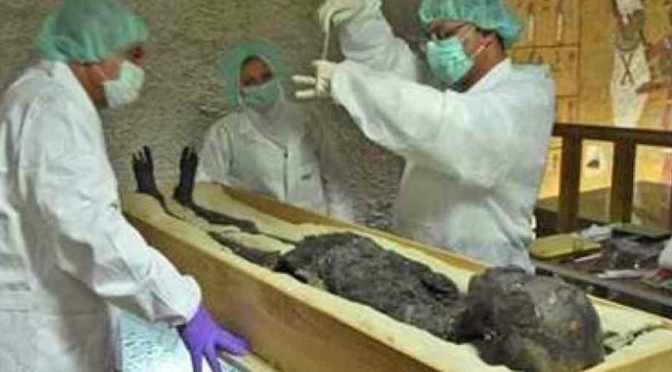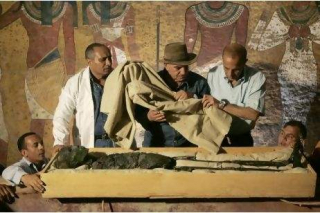 The Discovery Channel footage showed the whole action inside the tomb as preparations were made for the analysis of Tutankhamun’s DNA.
The Discovery Channel footage showed the whole action inside the tomb as preparations were made for the analysis of Tutankhamun’s DNA.
Stock Footage?
The Discovery Channel, like many other commercial channels, frequently makes use of “stock footage” in order to keep costs down. Is it possible that the DNA tests shown were from some other DNA sample? It seems unlikely as there is little doubt that the extraction sequences were actually within the tomb in Egypt. Why would they then insert stock footage for the testing? Nevertheless there has been no official release of the results and the geneticists who carried out the tests are very critical of iGENIA’s “professionalism”. In any case what Is the significance of Tutankhamun belonging to a particular Haplogroup
Hierachical DNA
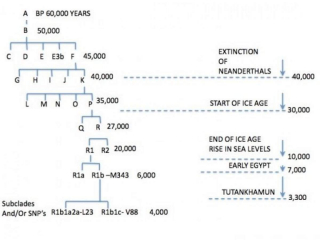 The analysis of DNA makes it possible to build a hierachical tree showing the mutations at various points in history and comparing them with known historical events.
This is not a user friendly system! Though the same letters are used there is no direct link between YDNA Haplogroups and Mt DNA Haplogroups. Letters are also used for the “short names” of SNP’s but...
The short name for R1b1a2a is L23. This is nothing to do with YDNA haplogroup L. The short name simply tells us that this sub clade was discovered ( isolated ) by Thomas Krahn, MSc of Family Tree DNA's Genomics Research Center and the sub clade was named in honour of the late Leo Little.
Similarly the “North African” (Berber?) version of R1b, V88 was discovered ( isolated ) by Rosaria Scozzari and Fulvio Cruciani, Università "La Sapienza", Rome, Italy.
There are now sub clades being identified for individual family names, notably the Sinclairs (St Clares). these are known as “private SNP’s!” There is a good chance that the discovery of a new sub clade or Haplogroup will cause a need for the renumbering of previous discoveries or a restructuring of the Haplogroup tree. Because of this many professional references give not only the current name but the previous names through several iterations.
The estimates of times between mutations has also varied from time to time and even between different practicioners. The dates shown have selectively taken from differing reports (by the author) to support a particular argument.The analysis of DNA and particularly the analysis of SNP’s and Mitrochondri makes it possible to build a hierachical tree showing the mutations at various points in history and comparing them with known historical events. This is not a user friendly system! Though the same letters are used there is no direct link between YDNA Haplogroups and Mt DNA Haplogroups. Letters are also used for the “short names” of SNP’s but…
The analysis of DNA makes it possible to build a hierachical tree showing the mutations at various points in history and comparing them with known historical events.
This is not a user friendly system! Though the same letters are used there is no direct link between YDNA Haplogroups and Mt DNA Haplogroups. Letters are also used for the “short names” of SNP’s but...
The short name for R1b1a2a is L23. This is nothing to do with YDNA haplogroup L. The short name simply tells us that this sub clade was discovered ( isolated ) by Thomas Krahn, MSc of Family Tree DNA's Genomics Research Center and the sub clade was named in honour of the late Leo Little.
Similarly the “North African” (Berber?) version of R1b, V88 was discovered ( isolated ) by Rosaria Scozzari and Fulvio Cruciani, Università "La Sapienza", Rome, Italy.
There are now sub clades being identified for individual family names, notably the Sinclairs (St Clares). these are known as “private SNP’s!” There is a good chance that the discovery of a new sub clade or Haplogroup will cause a need for the renumbering of previous discoveries or a restructuring of the Haplogroup tree. Because of this many professional references give not only the current name but the previous names through several iterations.
The estimates of times between mutations has also varied from time to time and even between different practicioners. The dates shown have selectively taken from differing reports (by the author) to support a particular argument.The analysis of DNA and particularly the analysis of SNP’s and Mitrochondri makes it possible to build a hierachical tree showing the mutations at various points in history and comparing them with known historical events. This is not a user friendly system! Though the same letters are used there is no direct link between YDNA Haplogroups and Mt DNA Haplogroups. Letters are also used for the “short names” of SNP’s but…
The short name for R1b1a2a is L23. This is nothing to do with YDNA haplogroup L. The short name simply tells us that this sub clade was discovered (isolated) by Thomas Krahn, MSc of Family Tree DNA’s Genomics Research Center and the sub clade was named in honour of the late Leo Little!
The estimates of times between mutations has also varied from time to time and even between different practitioners. The dates shown have selectively taken from differing reports.
Sample Sizes
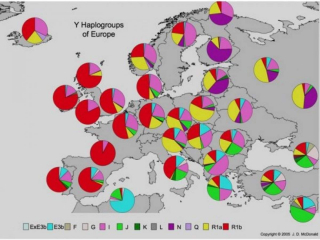 The population samples,on which all the statistics are based, are currently too small to give great confidence in the outcomes.
There are significant differences in findings between different research organisations.
Currently the reasons for submitting to DNA testing are predominantly personal.
There is therefore a suspicion that far too many of the samples are concentrated in the upper socio-economic levels.
Civil libitarians are very concerned to prevent wide scale testing.
However in ten years time the sample sizes will be much bigger and the samples more representative. In the meantime what is available gives a snapshot of current knowledge and some valuable information on which to base further speculation.The population samples,on which all the statistics are based, are currently too small to give great confidence in the outcomes.
The population samples,on which all the statistics are based, are currently too small to give great confidence in the outcomes.
There are significant differences in findings between different research organisations.
Currently the reasons for submitting to DNA testing are predominantly personal.
There is therefore a suspicion that far too many of the samples are concentrated in the upper socio-economic levels.
Civil libitarians are very concerned to prevent wide scale testing.
However in ten years time the sample sizes will be much bigger and the samples more representative. In the meantime what is available gives a snapshot of current knowledge and some valuable information on which to base further speculation.The population samples,on which all the statistics are based, are currently too small to give great confidence in the outcomes.
Currently the reasons for submitting to DNA testing are predominantly personal. There is therefore a suspicion that far too many of the samples are concentrated in the upper socio-economic levels. Some civil libertarians are very concerned to prevent wide scale testing. However in ten years time the sample sizes will be much bigger and the samples more representative. In the meantime what is available gives a snapshot of current knowledge and some valuable information on which to base further speculation.
World Wide Y-DNA Distributions
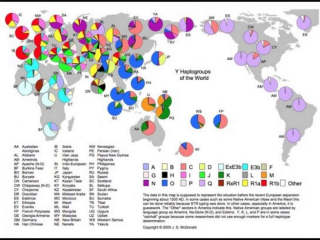 The diagrams constructed by J D McDonald give a useful indication of the European and World distribution of Y-DNA Haplogroups. This is extremely useful when considering the timing and location of significant mutations.Diagrams Such as those constructed by J D McDonald give an indication of the European and World distribution of Y-DNA Haplogroups. This is extremely useful when considering the timing and location of significant mutations.
The diagrams constructed by J D McDonald give a useful indication of the European and World distribution of Y-DNA Haplogroups. This is extremely useful when considering the timing and location of significant mutations.Diagrams Such as those constructed by J D McDonald give an indication of the European and World distribution of Y-DNA Haplogroups. This is extremely useful when considering the timing and location of significant mutations.
Sub Clades
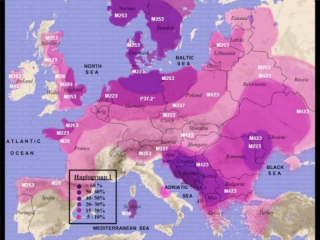 Sub clades, which are more recent mutations, are equally important. This diagram shows the distribution of accepted SNP’s of the Haplogroup I.
New SNP’s are isolated almost every day. Unfortunately the preference for using the “short” description hides the mutation sequences and therefore impedes an understanding of where each mutation probably occured. It is of course possible to prepare conversion charts.
Alternatively this type of diagram gives most of the picture. It can be seen that there are two epicentres of the spread of sub clades of I. In Scandinavia M253 dominates, in Bosnia M423. The spread is however less than predictable. M253 appears in northern Scotland though at lower frequences. This might be expected as Clan Gunn is Scandinavian.
Less easy to explain is how M423 has reached Scotland from Bosnia. There are two possible explanations. Possibly the Romans brought it with them. More likely it was the fact that Scots merchants traditionally looked east for their trading, through the Baltic and down the Russian rivers. There were Scottish settlements on the Volga, where as can be seen M423 is also prevalent.Sub clades, which are more recent mutations, are equally important. This diagram shows the distribution of accepted SNP’s of the Haplogroup I. New SNP’s are isolated almost every day. Unfortunately the preference for using the “short” description hides the mutation sequences and therefore impedes an understanding of where each mutation probably occured. It is of course possible to prepare conversion charts.
Sub clades, which are more recent mutations, are equally important. This diagram shows the distribution of accepted SNP’s of the Haplogroup I.
New SNP’s are isolated almost every day. Unfortunately the preference for using the “short” description hides the mutation sequences and therefore impedes an understanding of where each mutation probably occured. It is of course possible to prepare conversion charts.
Alternatively this type of diagram gives most of the picture. It can be seen that there are two epicentres of the spread of sub clades of I. In Scandinavia M253 dominates, in Bosnia M423. The spread is however less than predictable. M253 appears in northern Scotland though at lower frequences. This might be expected as Clan Gunn is Scandinavian.
Less easy to explain is how M423 has reached Scotland from Bosnia. There are two possible explanations. Possibly the Romans brought it with them. More likely it was the fact that Scots merchants traditionally looked east for their trading, through the Baltic and down the Russian rivers. There were Scottish settlements on the Volga, where as can be seen M423 is also prevalent.Sub clades, which are more recent mutations, are equally important. This diagram shows the distribution of accepted SNP’s of the Haplogroup I. New SNP’s are isolated almost every day. Unfortunately the preference for using the “short” description hides the mutation sequences and therefore impedes an understanding of where each mutation probably occured. It is of course possible to prepare conversion charts.Alternatively this type of diagram gives most of the picture. It can be seen that there are two epicentres of the spread of sub clades of I. In Scandinavia M253 dominates, in Bosnia M423. The spread is however less than predictable. M253 appears in northern Scotland though at lower frequences. This might be expected as Clan Gunn is Scandinavian.
Less easy to explain is how M423 has reached Scotland from Bosnia. There are two possible explanations. Possibly the Romans brought it with them. More likely it was the fact that Scots merchants traditionally looked east for their trading, through the Baltic and down the Russian rivers. There were Scottish settlements on the Volga, where as can be seen M423 is also prevalent.
There are now sub clades being identified for individual family names, notably the Sinclairs (St Clares). these are known as “private SNP’s!” There is a good chance that the discovery of a new sub clade or Haplogroup will cause a need for the renumbering of previous discoveries or a restructuring of the Haplogroup tree. Because of this many professional references give not only the current name but the previous names through several iterations.
Conversion Charts
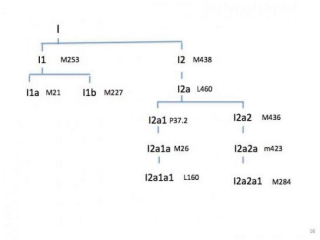 Nevertheless short names do mask some important information. The “long Name" for M253 is I1
The long name for M423 is I2a2. M284, which is found in England is I2a2a1. Therefore M284 is a mutation from M423 and therefore arrived in England from Scotland. This information is not immediately obvious from the short names.
It is the combination of geographical information with the haplogroup hierachy which yields new insights.Short names do mask some important information. The “long Name” for M253 is I1
Nevertheless short names do mask some important information. The “long Name" for M253 is I1
The long name for M423 is I2a2. M284, which is found in England is I2a2a1. Therefore M284 is a mutation from M423 and therefore arrived in England from Scotland. This information is not immediately obvious from the short names.
It is the combination of geographical information with the haplogroup hierachy which yields new insights.Short names do mask some important information. The “long Name” for M253 is I1
The long name for M423 is I2a2. Its highest concentration is found in Scotland. M284, which is found in England has the long name I2a2a1. Therefore, it can be deduced that M284 which occurs in England is a mutation from M423 and therefore is derived from a scottish emigrant. This information is not immediately obvious from the short names. It is the combination of geographical information with the haplogroup hierachy which yields new insights.
Mt DNA Distributions
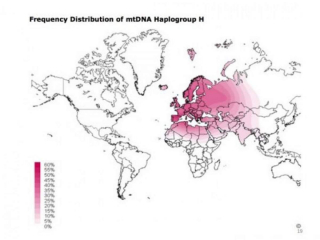 The Mt DNA Haplogoups can be similarly subdivided and analysed.
Please remember that Mt Dna Haplogroup H has no connection whatsover with Y DNA Haplogroup H.
Geneticists have called her Helen, Eve's daughter in the Pyrenees
As can be seen Mitrichondral H as the same epicentre as for the R1 YDNA occurs, though perhaps a little further south.The Mt DNA Haplogroups can be similarly subdivided and analysed. Please remember that Mt Dna Haplogroup H has no connection whatsoever with Y DNA Haplogroup H.
The Mt DNA Haplogoups can be similarly subdivided and analysed.
Please remember that Mt Dna Haplogroup H has no connection whatsover with Y DNA Haplogroup H.
Geneticists have called her Helen, Eve's daughter in the Pyrenees
As can be seen Mitrichondral H as the same epicentre as for the R1 YDNA occurs, though perhaps a little further south.The Mt DNA Haplogroups can be similarly subdivided and analysed. Please remember that Mt Dna Haplogroup H has no connection whatsoever with Y DNA Haplogroup H.
Geneticists have called the matriarch of Mt-dna Group H Helen, Eve’s daughter in the Pyrenees.
As can be seen Mitrichondral H as the same epicentre as for the R1 YDNA occurs, though perhaps a little further south.
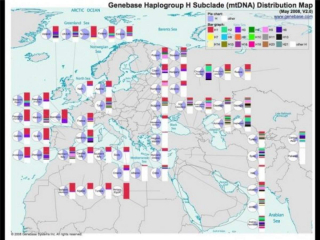 It can be seen however that there is a wider distribution of Mt DNA in almost every region than there was for the R1b Y DNAHowever that there is a wider distribution of group H Mt DNA in almost every region than there was for the R1b Y DNA.
It can be seen however that there is a wider distribution of Mt DNA in almost every region than there was for the R1b Y DNAHowever that there is a wider distribution of group H Mt DNA in almost every region than there was for the R1b Y DNA.
